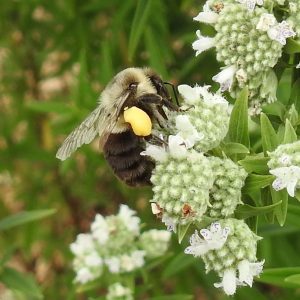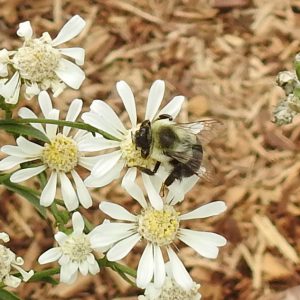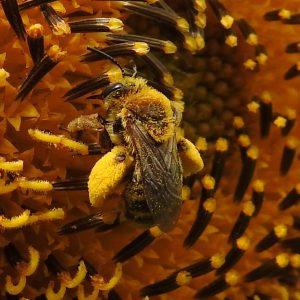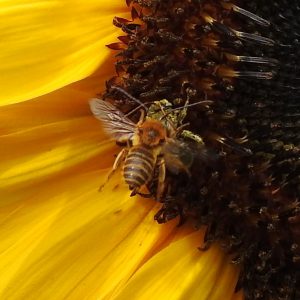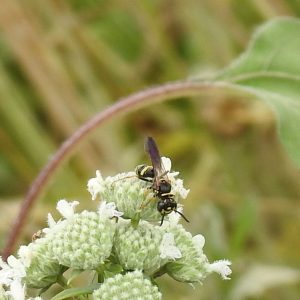by Sandy Garland
On Sunday afternoon, 18 August, Véronique, Jasmine, and I did a survey of pollinators in the gardens at Sunnyside library. For many years, these beds were carefully tended by the library’s custodian, John. When he retired, a group of residents – the Green Dreamers – volunteered to take over responsibility for maintaining these gardens.
The beds along the street are dominated by sunflowers during the summer. Earlier in the year, you can see the variety of plants that make up the beds. In the last few years, the Fletcher Wildlife Garden has donated native perennials to the cause.
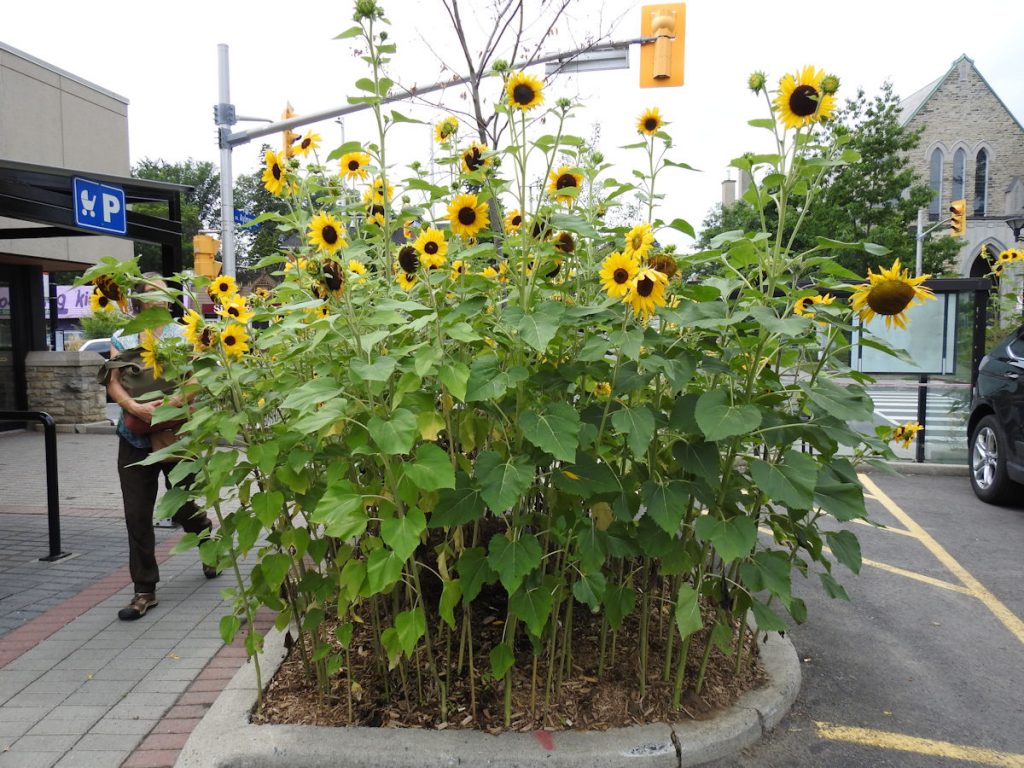
In summer, the library’s garden is dominated by giant sunflowers.
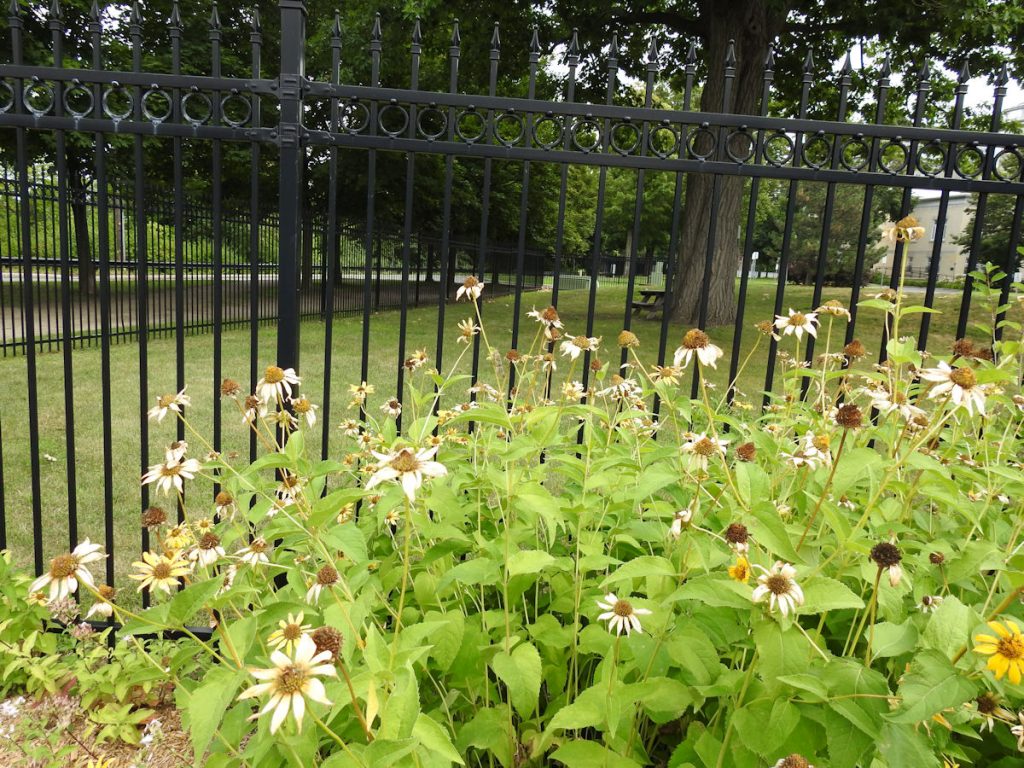
The “back bed” along the fence between the library and the neighbouring Royal College of Physicians and Surgeons of Canada contains a variety of perennials including these False Sunflowers (Heliopsis helianthoides).
The large sunflowers were clearly the favourites in this garden in term of number of bees visiting them, but we saw only Eumelissodes and Common Bumble Bees species on them. Mountain Mint – in fact all mints – also seem to be bee magnets.
These gardens are fairly small and have the disadvantage of bordering on a busy parking lot. We were surprised to see so many bees, although not the diversity we’ve found in other gardens. See Finding pollinators at Lansdowne, where we surveyed the same day.
We spent about half an hour looking for and photographing pollinators here. Véronique was able to use her phone to upload a photo of the small bees that were all over the sunflowers and iNaturalist suggested they were Melissodes (a type of long-horned bee). Later, we uploaded all photos to iNaturalist and over the next few days, many were identified by the experts who review this information. We didn’t get photos of all the pollinators we saw (some are very quick)
Survey form
Date and time of survey: Aug. 18, 1:10-1:36 pm
Temperature: 22°C
Wind speed: 2.2 m/s (7.9 k/h)
Sky: >90% cloud cover
*Indicates photo submitted to iNaturalist. Note: Sunflower and Cosmos are not native species; all other flowers listed here are native.
| Pollinator | Flower | |||
| Common name | Scientific name | No. | Common name | Scientific name |
| *Long-horned Bee | Eumelissodes | 50+ | Sunflower | Helianthus annuus |
| *Long-horned Bee | Eumelissodes | 3 | False Sunflower | Heliopsis helianthoides |
| Cabbage White | Pieris rapae | 3 | False Sunflower | Heliopsis helianthoides |
| *Long-horned Bee | Eumelissodes | 2 | Cosmos | Cosmos sp. |
| Common Eastern BB | Bombus impatiens | 1 | Anise Hyssop | Agastache foeniculum |
| *Common Eastern BB | Bombus impatiens | 3 | Mountain Mint | Pycnanthemum virginianum |
| Ligated Furrow Bee | Halictus ligatus | 10+ | Sunflower | Helianthus annuus |
| *Ligated Furrow Bee | Halictus ligatus | 1 | Grey-headed Coneflower | Ratibida pinnata |
| Bumble bee (yellow legs) | Bombus sp. | 2 | Joe-Pye Weed | Eutrochium purpureum |
| *Striped sweat bee | Agopostemon sp. | 3 | Joe-Pye Weed | Eutrochium purpureum |
Missing from the form
Humped Beewolf (Philanthus gibbosus) on Mountain Mint
What did we learn
We learned that there was such a thing as a Furrow Bee, and I’m beginning to recognize this species when I see it: small and black with widely-spaced yellow stripes on abdomen, light yellow or orange legs. A member of the sweat bee group, it is also one of the many native bees that burrow into the ground to make nests for laying eggs.
We also learned that we should mark on the form when we get a good photo of a bee, to make later matching of data easier. We quite often write “tiny black bee” on the form and only later learn which family it belongs to. Knowing there’s a photo of this bee would help considerably.
We learned that one survey is only a snapshot and to collect “good” data on the number of pollinators visiting a site, we would have to survey at least once a week to avoid missing some completely. Many native bees live only a few weeks. In that time, they must find or make a place to lay eggs, mate and lay those eggs, then provision them with enough pollen and nectar to feed the larvae that emerge and need to grow big enough to pupate, then turn into an adult, usually the following year.
We learned that this annual species of sunflower (non-native) is an important source of food for some pollinators. But the native plants in this garden had many diverse visitors.

